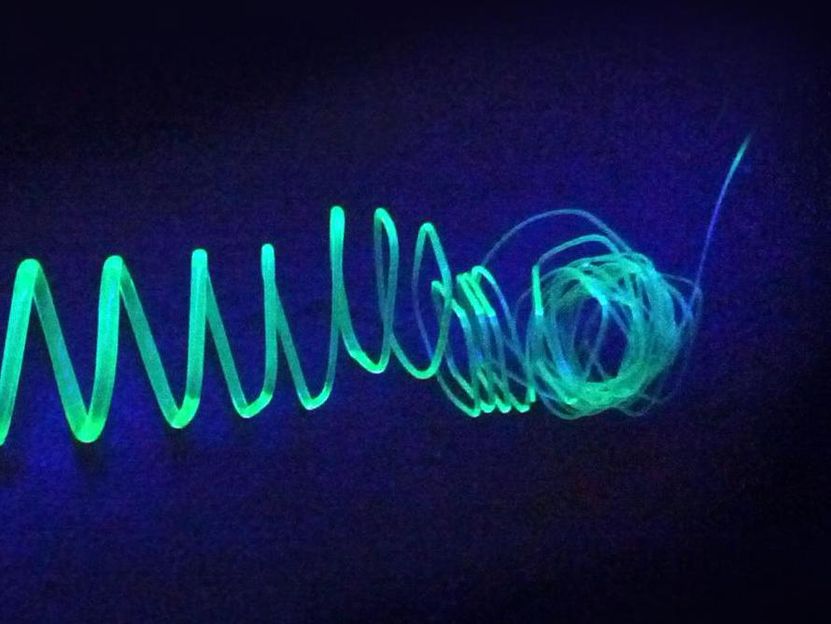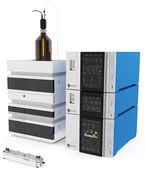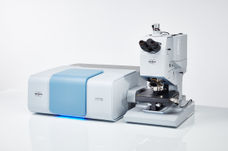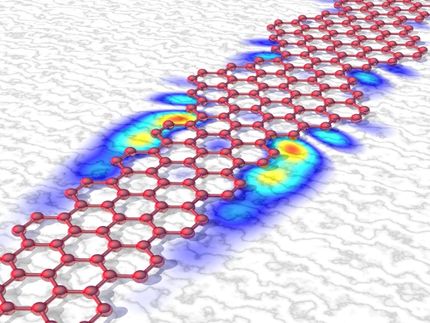A perfect team for nanoelectronics
Polymer-coated silicon nanosheets as alternative to graphene
silicon nanosheets are thin, two-dimensional layers with exceptional optoelectronic properties very similar to those of graphene. Albeit, the nanosheets are less stable. Now researchers at the Technical University of Munich (TUM) have, for the first time ever, produced a composite material combining silicon nanosheets and a polymer that is both UV-resistant and easy to process. This brings the scientists a significant step closer to industrial applications like flexible displays and photosensors.

Extruded spiral made of polymer-coated silicon-nanosheets glowing in UV light
Tobias Helbich / TUM
Similar to carbon, silicon forms two dimensional networks that are only one atomic layer thick. Like graphene, for whose discovery Andre Geim and Konstantin Novoselov received the Nobel Prize in 2010, these layers possess extraordinary optoelectrical properties. Silicon nanosheets might thus find application in nanoelectronics, for example in flexible displays, field-effect transistors and photodetectors. With its ability to store lithium ions, it is also under consideration as an anode material in rechargeable lithium batteries.
"Silicon nanosheets are particularly interesting because today's information technology builds on silicon and, unlike with graphene, the basic material does not need to be exchanged," explains Tobias Helbich from the WACKER Chair for Macromolecular Chemistry at TUM. "However, the nanosheets themselves are very delicate and quickly disintegrate when exposed to UV light, which has significantly limited their application thus far."
Polymer and nanosheets - the best of both worlds in one
Now Helbich, in collaboration with Professor Bernhard Rieger, Chair of Macromolecular Chemistry, has for the first time successfully embedded the silicon nanosheets into a polymer, protecting them from decay. At the same time, the nanosheets are protected against oxidation. This is the first nanocomposite based on silicon nanosheets.
"What makes our nanocomposite special is that it combines the positive properties of both of its components," explains Tobias Helbich. "The polymer matrix absorbs light in the UV domain, stabilizes the nanosheets and gives the material the properties of the polymer, while at the same time maintaining the remarkable optoelectronic properties of the nanosheets."
Long-term goal of nanoelectronics - In leaps and bounds to industrial application
Its flexibility and durability against external influences also makes the newly developed material amenable to standard polymer technology for industrial processing. This puts actual applications within an arm's reach.
The composites are particularly well suited for application in the up and coming field of nanoelectronics. Here, "classical" electronic components like circuits and transistors are implemented on scales of less than 100 nanometers. This allows whole new technologies to be realized - for faster computer processors, for example.
Nanoelectronic photodetector
The first successful application of the nanocomposite constructed by Helbich was only recently presented in the context of the ATUMS Graduate Program (Alberta / TUM International Graduate School for Functional Hybrid Materials): Alina Lyuleeva and Prof. Paolo Lugli from the Institute of Nanoelectronics at TU Munich, in collaboration with Helbich and Rieger, succeeded in building a photodetector based on these silicon nanosheets.
To this end, they mounted the polymer embedded silicon nanosheets onto a silicon dioxide surface coated with gold contacts. Because of its Lilliputian dimensions, this kind of nanoelectronic detector saves a lot of both space and energy.
Original publication
Other news from the department science
These products might interest you

Eclipse by Wyatt Technology
FFF-MALS system for separation and characterization of macromolecules and nanoparticles
The latest and most innovative FFF system designed for highest usability, robustness and data quality

Spinsolve Benchtop NMR by Magritek
Spinsolve Benchtop NMR
Spinsolve is a revolutionary multinuclear NMR spectrometer that provides the best performance

HYPERION II by Bruker
FT-IR and IR laser imaging (QCL) microscope for research and development
Analyze macroscopic samples with microscopic resolution (5 µm) in seconds

Get the chemical industry in your inbox
By submitting this form you agree that LUMITOS AG will send you the newsletter(s) selected above by email. Your data will not be passed on to third parties. Your data will be stored and processed in accordance with our data protection regulations. LUMITOS may contact you by email for the purpose of advertising or market and opinion surveys. You can revoke your consent at any time without giving reasons to LUMITOS AG, Ernst-Augustin-Str. 2, 12489 Berlin, Germany or by e-mail at revoke@lumitos.com with effect for the future. In addition, each email contains a link to unsubscribe from the corresponding newsletter.
Most read news
More news from our other portals
Last viewed contents
Arkema appoints Velox as European distributor for its Multiwall Carbon Nanotubes

Mosquito-repelling chemicals identified in traditional sweetgrass
Huntsman Completes Amines Expansion in Llanelli, Wales
Cereplast to Establish Italy-Based Bioplastic Manufacturing Plant - Plant Expected to Have 100,000 Tons of Capacity



























































